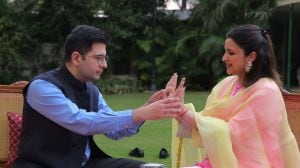Diwali is a five-day festival and each day holds a special significance. The Govardhan Puja occurs on the first lunar day of Shukla Paksha in the month of Kartik, which is the fourth day of Diwali, the festival of lights. It is a Hindu festival when devotees pay obeisance to Lord Krishna on this day.
“On this auspicious day, devotees offer their prayers to Lord Krishna as it is believed that today’s marks the victory of Krishna Kanhaiya over the arrogance of Lord Indra. Devotees also offer prayers to the pile of grains, which symbolizes the Govardhan mountain,” said Pankaj Khanna, Chairman, Khanna Gems.
Also Read | Solar Eclipse 2022: Year’s last Surya Grahan today; City-wise timing, when and where to watch
“Govardhan pooja which is also known as Annakut or Annakoot is a festival celebrated in India, basically it is an Hindu festival where devotees prepare and offers large variety of vegetarian food to their parmatmas (God) as a gesture of gratitude, and also to give their gods a vote of thanks and specially to worshiped Lord Krishna,” Khanna added.
Usually celebrated a day after Deepavali but due to solar eclipse on 25th October ,this year the festival falls on October 26 ,2022.
Govardhan Puja Muhurat
Pankaj Khanna told FinancialExpress.com that according to religious texts, Govardhan Puja is conducted during the Pratipada Tithi of Kartik month. The Govardhan puja is conducted in the morning as well as the evening. Here are the mahurat timings for conducting a puja.
Pratipada Tithi Begins at 22:48 on October 25, 2022
Pratipada Tithi Ends at 21.12 on October 26, 2022
Govardhan Puja Pratahkal Muhurat — 5.34 am to 8:06 am on October 26, 2022
Duration: 2 hours 14 mins
Govardhan Puja Sayankal Muhurat —15.41 to 18.13 on October 26, 2022
Duration: 2 hours 32 mins
Significance of Goverdhan Pooja
“According to Bhagavad Puran, the people of Braj (the adjoining areas between Mathura and Vrindavan) used to worship Indra, the god of rain and storm, as well as the king of all gods during the autumn season, thanking him for the bountiful rains and good harvest. However, Krishna thought that instead of thanking a distant God, they should thank the Mount Govardhan that stood in the middle of the habitation. Irked by people praying Govardhan, Indra decided to punish the locals with heavy torrential rain, it then when Krishna lifted the mountain to provide shelter and protection to the people. After much trial and tribulation, Indra accepted that he could not harm the villagers and realised that he had let his ego dictate his actions, thus, conceding defeat,” said Pankaj Khanna.
“When Krishna urged people to thank Mount Govardhan for his offerings, he asked people to create a mountainous offering of food and delicacies for a ‘giri yagna’. It is said that Krishna himself, then assumed the form of a mountain himself and accepted the villagers’ offerings.
Thus, on this special day, people prepare elaborate vegetarian meals of 56 or 108 different kinds of dishes made with wheat, rice, gram flour. Delicious food using leafy vegetables, milk, pulses, and fruits are also cooked and offered to Lord Krishna on this day,” Khanna explained.
Govardhan Pooja: Celebration
Khanna further said, “Devotees perform this pooja by making hillocks of cow-dung which represents the Mount Govardhan, the mountain Krishna had lifted. The small hillock is adorned with flowers and devotees circumambulate the hillock and pray to Lord Govardhan, asking him to protect their families. People also pray to Lord Krishna who taught people to worship the nature.”









